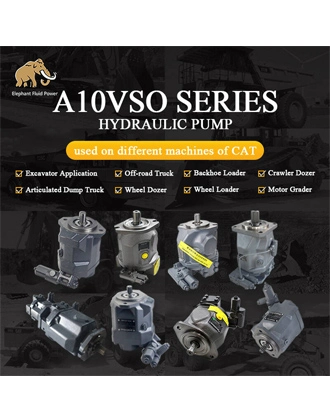The hydraulic pump is mainly composed of the following parts:
First. Pump body
1. Function: It is the main structure of the hydraulic pump, providing installation support and protection for other components, and at the same time forming the flow channel and accommodating chamber of the hydraulic oil.
2. Features: Usually made of high-strength metal materials, with good sealing and pressure resistance, able to withstand high pressure in hydraulic systems.
Second. Plunger/gear/vane (according to different types of pumps)
1. Plunger (for piston pump): reciprocating motion in the cylinder body, by changing the volume of the working cavity to achieve oil suction and oil pressure. The plunger is usually made of high-strength alloy steel with a precision machined surface to ensure a good fit and tightness with the cylinder block.
2. Gears (for gear pumps): Gears that mesh with each other rotate inside the pump body to deliver hydraulic oil from the suction port to the pressure port. The gears are generally made of high-quality alloy steel, which has high hardness and wear resistance.
3. Vane (for vane pump): Installed in the rotor groove, with the rotation of the rotor, the blades are stretched out under the action of centrifugal force and pressure oil, and are close to the inner surface of the stator to form a plurality of sealed working cavities. Blades are usually made of wear-resistant materials such as high-speed steel or ceramic.
Third. Distribution device
1. Function: Responsible for distributing the inflow and outflow of hydraulic oil to ensure the normal operation of the hydraulic pump. For piston pumps, the distribution tray is a common distribution device; In the case of gear pumps and vane pumps, the distribution is usually achieved through a specific structure on the pump body.
2. Features: The distribution device needs to have good sealing and wear resistance to prevent hydraulic oil leakage and ensure long-term stable operation.
Fourth, the drive shaft
1. Function: Connect the hydraulic pump to the power source (such as an engine or electric motor) to transmit power to the internal parts of the pump so that they can operate.
2. Features: The drive shaft is usually made of high-strength alloy steel, which has enough strength and rigidity to withstand the transmitted torque and power.
Fifth. Seals
1. Function: Prevent hydraulic oil leakage and ensure stable pressure and flow inside the hydraulic pump. Seals include shaft seals, sealing rings, etc., which are installed in different parts of the pump.
2. Features: Seals need to have good elasticity, wear resistance and corrosion resistance, and be able to adapt to different working temperature and pressure conditions.
Sixth. Bearings
1. Function: Support the drive shaft and other rotating parts, reduce friction and wear, and ensure the smooth operation of the pump.
2. Features: The bearings are usually rolling bearings or sliding bearings, which have the characteristics of high load capacity, low friction coefficient and long life.
The above is the introduction of hydraulic pump parts, I hope it will help you.
Hydraulic pump parts list
Hydraulic pump replacement parts
Mechanical hydraulic pump parts
 French
French
 Portuguese
Portuguese
 Russian
Russian
 German
German
 Spanish
Spanish
 Japanese
Japanese
 Korean
Korean
 Irish
Irish
 Greek
Greek
 Turkish
Turkish
 Italian
Italian
 Danish
Danish
 Romanian
Romanian
 Indonesian
Indonesian
 Czech
Czech
 Afrikaans
Afrikaans
 Swedish
Swedish
 Polish
Polish
 Basque
Basque
 Catalan
Catalan
 Esperanto
Esperanto
 Hindi
Hindi
 Lao
Lao
 Albanian
Albanian
 Amharic
Amharic
 Armenian
Armenian
 Azerbaijani
Azerbaijani
 Belarusian
Belarusian
 Bengali
Bengali
 Bosnian
Bosnian
 Bulgarian
Bulgarian
 Cebuano
Cebuano
 Chichewa
Chichewa
 Corsican
Corsican
 Croatian
Croatian
 Dutch
Dutch
 Estonian
Estonian
 Filipino
Filipino
 Finnish
Finnish
 Frisian
Frisian
 Galician
Galician
 Georgian
Georgian
 Gujarati
Gujarati
 Haitian
Haitian
 Hausa
Hausa
 Hawaiian
Hawaiian
 Hebrew
Hebrew
 Hmong
Hmong
 Hungarian
Hungarian
 Icelandic
Icelandic
 Igbo
Igbo
 Javanese
Javanese
 Kannada
Kannada
 Kazakh
Kazakh
 Khmer
Khmer
 Kurdish
Kurdish
 Kyrgyz
Kyrgyz
 Latin
Latin
 Latvian
Latvian
 Lithuanian
Lithuanian
 Luxembourg
Luxembourg
 Macedoniar
Macedoniar
 Malagasy
Malagasy
 Malay
Malay
 Malayalam
Malayalam
 Maltese
Maltese
 Maori
Maori
 Marathi
Marathi
 Mongolian
Mongolian
 Burmese
Burmese
 Nepali
Nepali
 Norwegian
Norwegian
 Pashto
Pashto
 Persian
Persian
 Punjabi
Punjabi
 Serbian
Serbian
 Sesotho
Sesotho
 Sinhala
Sinhala
 Slovak
Slovak
 Slovenian
Slovenian
 Somali
Somali
 Samoan
Samoan
 Scots Gaelic
Scots Gaelic
 Shona
Shona
 Sindhi
Sindhi
 Sundanese
Sundanese
 Swahili
Swahili
 Tajik
Tajik
 Tamil
Tamil
 Telugu
Telugu
 Thai
Thai
 Ukrainian
Ukrainian
 Urdu
Urdu
 Uzbek
Uzbek
 Vietnamese
Vietnamese
 Welsh
Welsh
 Xhosa
Xhosa
 Yiddish
Yiddish
 Yoruba
Yoruba
 Zulu
Zulu







